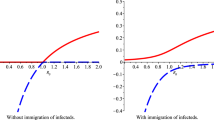Abstract
This paper is devoted to the mathematical analysis of a reaction and diffusion model for Lyme disease. In the case of a bounded spatial habitat, we obtain the global stability of either disease-free or endemic steady state in terms of the basic reproduction number R 0. In the case of an unbounded spatial habitat, we establish the existence of the spreading speed of the disease and its coincidence with the minimal wave speed for traveling fronts. Our analytic results show that R 0 is a threshold value for the global dynamics and that the spreading speed is linearly determinate.
Similar content being viewed by others
References
Barbour AG, Fish D (1993) The biological and social phenomenon of Lyme disease. Science 260: 1610–1616
Caraco T, Gardner G, Maniatty W, Deelman E, Szymanski BK (1998) Lyme disease: self-regulation and pathogen invasion. J Theor Biol 193: 561–575
Caraco T, Glavanakov S, Chen G, Flaherty JE, Ohsumi TK, Szymanski BK (2002) Stage-structured infection transmission and a spatial epidemic: A model for Lyme disease. Am Nat 160: 348–359
Fang J, Wei J, Zhao X-Q (2008) Spatial dynamics of a nonlocal and time-delayed reaction–diffusion system. J Differ Equ 245: 2749–2770
Hale JK (1988) Asymptotic behavior of dissipative systems. American Mathematical Society, Providence
Hsu S-B, Zhao X-Q (2008) Spreading speeds and traveling waves for nonmonotone integrodifference equations. SIAM J Math Anal 40: 776–789
Li B, Weinberger HF, Lewis MA (2005) Spreading speeds as slowest wave speeds for cooperative systems. Math Biosci 196: 82–98
Liang X, Zhao X-Q (2007) Asymptotic speeds of spread and traveling waves for monotone semiflows with applications. Commun Pure Appl Math 60: 1–40
Liang X, Yi Y, Zhao X-Q (2006) Spreading speeds and traveling waves for periodic evolution systems. J Differ Equ 231: 57–77
Lou Y, Zhao X-Q (2011) Modelling malaria control by introduction of larvivorous fish. Bull Math Biol. doi:10.1007/s11538-011-9628-6
Lui R (1989) Biological growth and spread modeled by systems of recursions. I. Mathematical theory. Math Biosci 93: 269–295
Martin RH, Smith HL (1990) Abstract functional differential equations and reaction–diffusion systems. Trans Am Math Soc 321: 1–44
Mollison D (1991) Dependence of epidemic and population velocities on basic parameters. Math Biosci 107: 255–287
Murray JD (2002) Mathematical biology, I: an introduction. Springer, New York
Royden HL (2010) Real analysis, 4th edn. Prentice Hall, Englewood Cliffs
Smith HL, Zhao X-Q (2001) Robust persistence for semidynamical systems. Nonlinear Anal 47: 6169–6179
Thieme HR (1979) On a class of Hammerstein integral equations. Manuscr Math 29: 49–84
Thieme HR (1992) Convergence results and Poincaré–Bendixson trichotomy for asymptotically autonomous differential equations. J Math Biol 30: 755–763
Thieme HR, Zhao X-Q (2001) A non-local delayed and diffusive predator-prey model. Nonlinear Anal RWA 2: 145–160
van den Bosch F, Metz JAJ, Diekmann O (1990) The velocity of spatial population expansion. J Math Biol 28: 529–565
Volpert AI, Volpert VA, Volpert VA (1994) Traveling wave solutions of parabolic systems. Translations of Mathematical Monographs, AMS
Wang W, Zhao X-Q (2011) A nonlocal and time-delayed reaction–diffusion model of Dengue transmission. SIAM J Appl Math 71: 147–168
Weinberger HF (1982) Long-time behavior of a class of biological models. SIAM J Math Anal 13: 353–396
Weinberger HF, Lewis MA, Li B (2002) Analysis of linear determinacy for spread in cooperative models. J Math Biol 45: 183–218
White DJ, Chang H-G, Benach JL, Bosler EM, Meldrum SC, Means RG, Debbie JG, Birkhead GS, Morse DL (1991) The Geographic spread and temporal increase of the Lyme disease epidemic. J Am Med Assoc 266: 1230–1236
Zhao X-Q (2003) Dynamical systems in population biology. Springer, New York
Author information
Authors and Affiliations
Corresponding author
Additional information
Research supported in part by the NSERC of Canada and the MITACS of Canada.
Rights and permissions
About this article
Cite this article
Zhao, XQ. Global dynamics of a reaction and diffusion model for Lyme disease. J. Math. Biol. 65, 787–808 (2012). https://doi.org/10.1007/s00285-011-0482-9
Received:
Revised:
Published:
Issue Date:
DOI: https://doi.org/10.1007/s00285-011-0482-9



